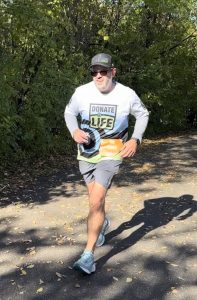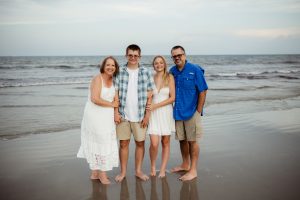My Kidney Donation Story: Chuck Miller

In November of 2022, I donated my left kidney to someone I’ve never met through the National Kidney Registry. In doing so, I enabled my wife, Karie, who has polycystic kidney disease, to receive a kidney from another living donor through the NKR’s Voucher Program. Karie activated her voucher that December and was transplanted with a near perfectly matching kidney in March of 2023.
The NKR Voucher Program was a great option for our family. Both my donation and Karie’s transplant were performed at Mayo Clinic, which requires you to have a dedicated adult caregiver for several weeks after each surgery.
Donating first and having Karie transplanted second gave me time to recover and then help take care of Karie following her surgery. With two teenagers in high school and both of us having full-time jobs, the voucher process was less disruptive to our family life and careers.
The NKR Voucher Program was a great option for our family. Donating first and having Karie transplanted second gave me time to recover and then help take care of Karie following her surgery.
Chuck Miller
And, because the NKR utilizes the latest generation in DNA sequencing technology to increase the odds of a better match through the Voucher Program, that usually means the kidney the NKR finds will last longer for the recipient and they will require less immune-suppressive medication. On top of this, the recipient can often avoid going on dialysis, which was the case with Karie and can lead to better transplant outcomes.
Many people throughout my donation process noted that I’ve helped not just one but two people by donating. However, they rarely mention how I’ve helped myself. To qualify for donation, I started eating and living healthier, exercising almost every day and losing 40 pounds over the course of a year.
I recovered quickly after donation because of those changes. Shortly after, I started running for the first time in my life, finishing my first 5K a little over two months after my surgery. The biggest achievement of that race, aside from running the entire time, is that I was neither fatigued nor out of breath. I kept on running and ran a half marathon this past October. I’m now training for a full marathon in June.
Many people throughout my donation process noted that I’ve helped not just one but two people by donating. However, they rarely mention how I’ve helped myself. To qualify for donation, I started eating and living healthier, exercising almost every day and losing 40 pounds over the course of a year
Chuck Miller
I also received world-class medical care from an extremely talented team of doctors, surgeons, nurses, social workers, and living donor advocates at the Mayo Clinic in Rochester, Minnesota. Throughout the donation process, they reinforced that my long-term health was just as important as being qualified to donate and matching my recipient.
Donating a kidney will likely be the most important thing I ever do. I can’t think of anything that might allow me to have a more significant, positive impact on the lives of Karie, my family, my recipient, or me.
If you’d like to learn more about organ donation and living organ donation, read this article by the doctor who performed my surgery. You can learn more about donating through the National Kidney Registry. And you can register to be an organ, eye, and tissue donor through Donate Life America here.
About the Author

Chuck Miller lives in Minnesota with his wife, Karie, and their two children, Jimmy and Liv. Along with being a husband and father, Chuck works in communications for a global food and agricultural company. Chuck and his family enjoy summers at their home on the lake and traveling to tropical destinations and U.S. National Parks. He is an avid runner and enjoys the outdoors, including hiking, hunting, and fishing.